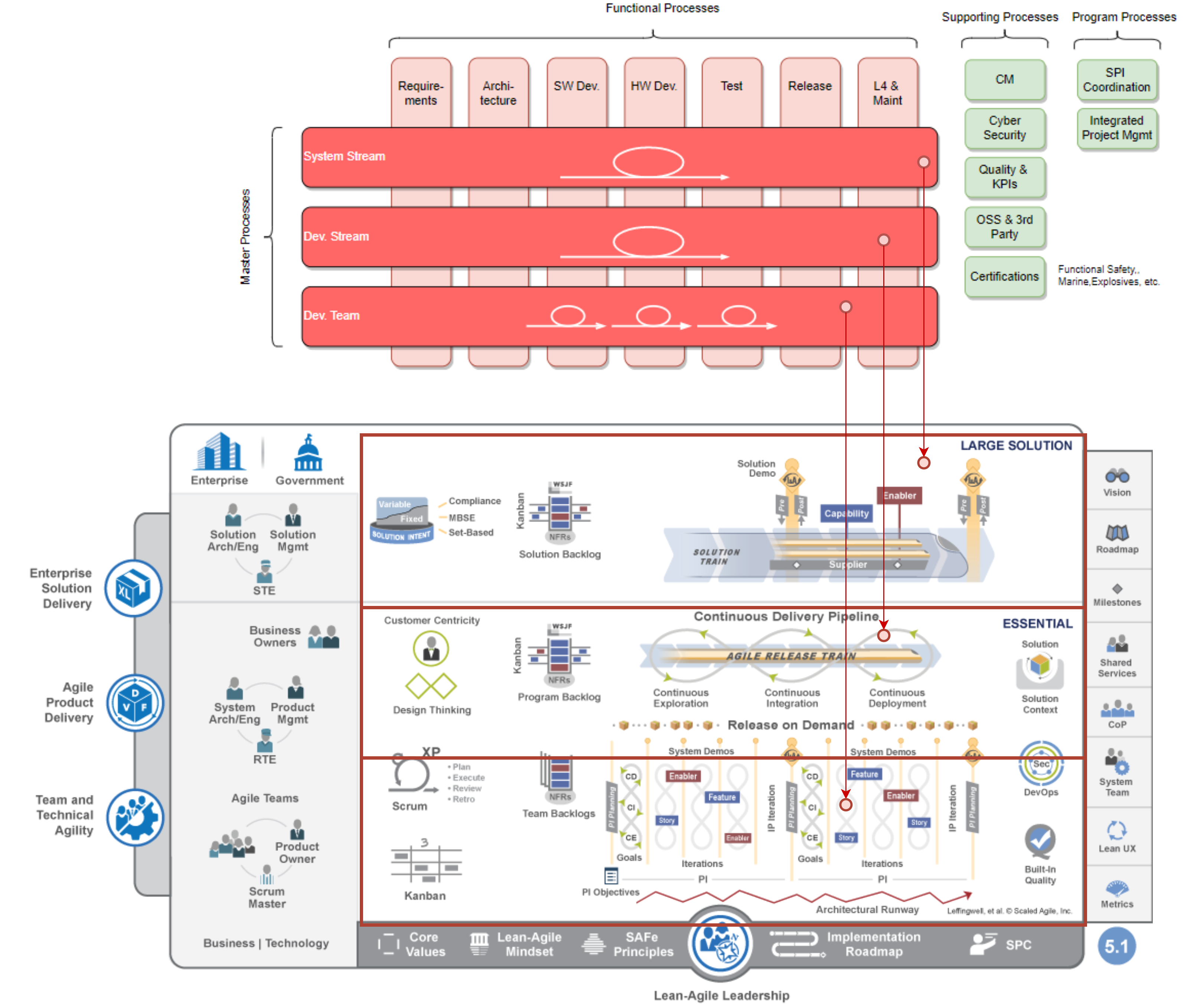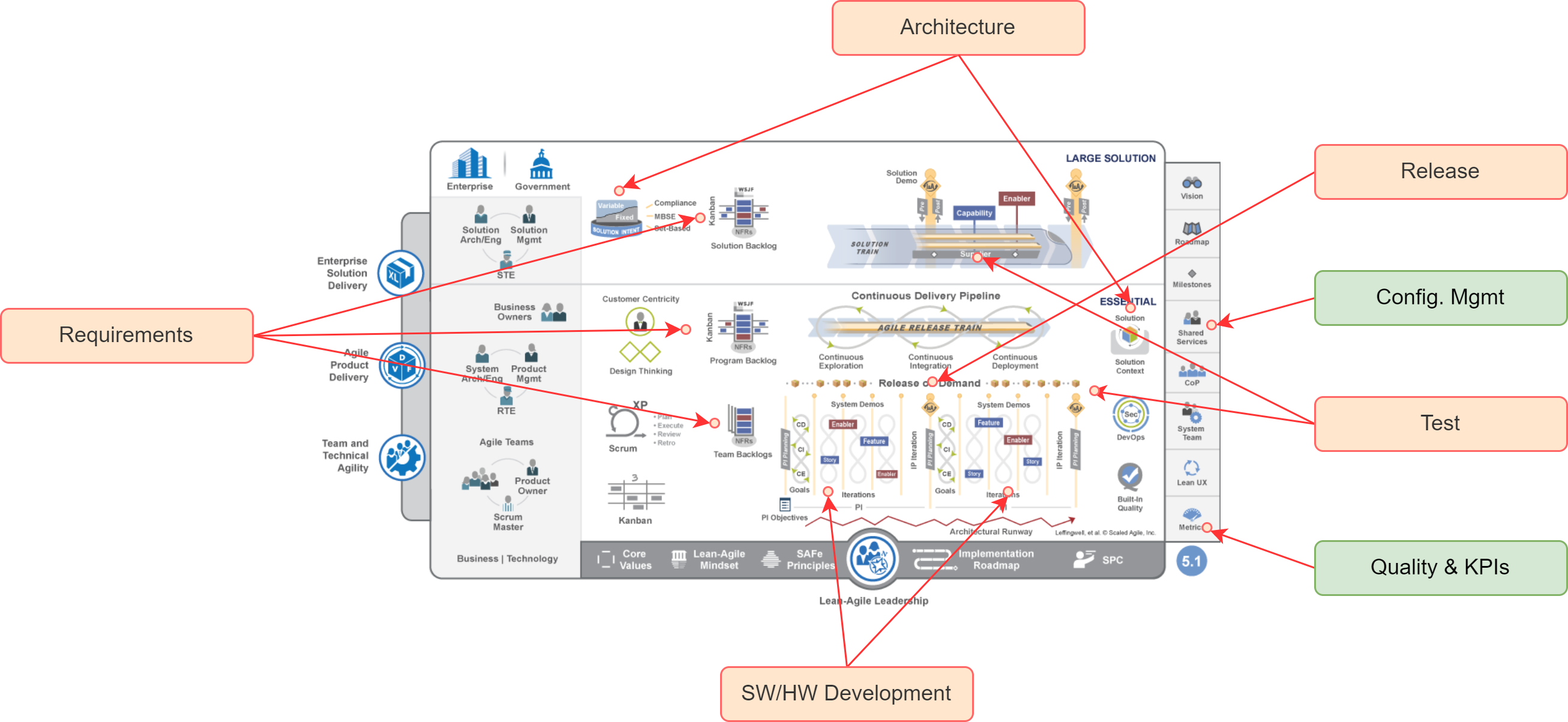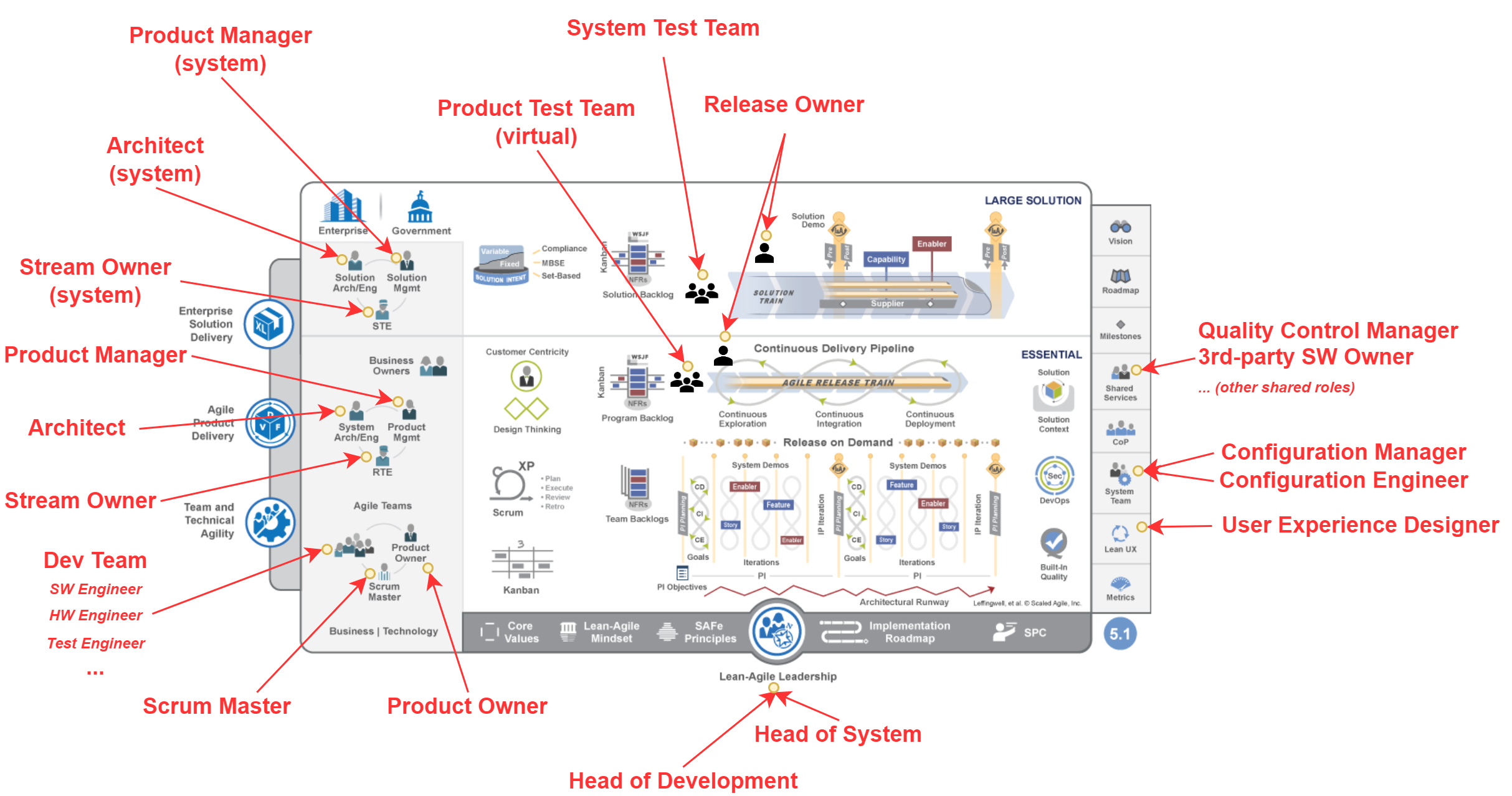Processes and SAFe
Mapping of the key parts of the PCP R&D Processes to Scaled Agile Framework (SAFe) is done, to give a better understanding of how the two frameworks can coexist and strengthen the lean-agile planning and execution in PCP R&D.
SAFe is a source of inspiration for lean-agile planning and execution in PCP R&D, e.g., Continuous Integration (CI), Continuous Deployment (CD), and DevOps.
The SAFe framework provides a way to benchmark the PCP R&D processes against lean-agile values, principles, and practices. Much of the lean-agile thinking, planning, and execution used in PCP R&D comes from the SAFe framework.
The PCP R&D process framework contains adaptations based on management decisions taken when the PCP process framework was developed and also based on the history of the organizations that became a part of PCP.
The Master processes are a subset of the SAFe framework. The description of the Master processes is minimal, viable, and especially focuses on PCP R&D adaptations (e.g., SPIs, System Streams, and Development Streams). Whenever possible, SAFe is referenced for details.
However, the Functional and Supporting processes are unique for PCP R&D, and here it isn’t possible to reference SAFe to the same extent. The PCP R&D process framework describes in more detail how to develop and release our products and systems. Also, the SAFe framework is tool agnostic, while PCP R&D must describe and configure template and tool adaptations.
To learn more about lean-agile, please visit the SAFe homepage. Here you can find information about professional lean-agile training provided by the SAFe framework. Most of these courses are available in your country through external training companies. It is also possible to talk to the certified SAFe SPCs in PCP R&D (they are authorized to use selected parts of SAFe training material internally).
PCP R&D Master Processes and SAFe
The Master processes in the PCP R&D Process framework are highly inspired by SAFe. The PCP R&D Master processes are minimal, and only the key events (meetings) and activities are described. Instead of copying and pasting information from SAFe to the PCP R&D framework, references to the SAFe framework are provided whenever possible.
Examples of information provided by SAFe are leadership, values, principles, cross-functional teams, and value streams. Here the Master processes and SAFe complement each other.

PCP R&D Functional and Supporting Processes and SAFe
The Functional processes in the PCP R&D process framework describe the development lifecycle for components, products, and systems (requirements -> architecture -> SW/HW Dev -> Test -> L4&Maintenance). These processes should be free from planning & execution activities (e.g., milestones, gates, activities/tasks), and rather focus on how to do things.
The Supporting processes (Configuration Management, 3rd-party & OSS, Security, Quality & KPIs) are the processes supporting other processes. They also go deep into details, e.g., describing how to work in Azure DevOps, audits, quality criteria, and how to work with 3rd-party applications.
The PCP process framework is stronger and more detailed than SAFe for the functional and supporting processes. Partly because the standards we must fulfill, require more details on how to perform activities (safety, security, etc.). There is still a relationship between SAFe and the Functional and Supporting processes, and we can make sure they also are aligned with the lean-agile values and principles.

PCP R&D Roles and SAFe
In PCP R&D, the roles are used to clearly describe responsibilities for people in the organization. Some of the roles are shared with SAFe (e.g. Scrum Master and Product Owners), some have similar meanings but different names (e.g. Release Owner, Strean Owner), and some roles are unique for PCP (e.g. Safety Engineer, Security Engineer, and 3rd-party SW Owner).

| PCP R&D Role | SAFe Role | Comment | Recommended SAFe Training1 |
|---|---|---|---|
| Head of System/ Head of Development | Lean-Agile Leadership | Management role for a Stream responsible for budget, resources, competence, etc. | - Leading SAFe |
| Stream Owner | Release Train Engineer/ Program Manager | The same person can be both Stream Owner and Head of Development (which is closer to what an RTE is). | - Leading SAFe - Release Train Engineer |
| Release Owner | - | Supports the Stream Owner keeping track of all activities and artifacts for a specific releases. There are no Project Manager role in SAFe. | - SAFe Release Train Engineer - SAFe for Teams |
| Product Manager | Product Management | At least one product manager is assigned to a Stream. | - Lean Portfolio Managment - SAFe Product Owner / Product Manager Agile Product Management |
| (Stream) Architect | System Architect | The "Stream Architect" in PCP R&D corresponds to the "System Architect" in SAFe. | - SAFe for Architects |
| (System) Architect | Solution Architect/Engineer | The "System Architect" in PCP R&D corresponds to the "Solution Architect" in SAFe. | - SAFe for Architects |
| Product Owner | Product Owner | Product Owner | - SAFe Product Owner / Product Manager |
| Scrum Master | Scrum Master | Scrum Master | - SAFe Scrum Master - SAFe Advanced Scrum Master |
| Agile Team | Agile Team | Agile Team | - SAFe for Teams |
| SteCo | Business Owners | The SteCo with PPM and R&D are responsible for both business, technology, and quality - and represents the customer. | - Leading SAFe |
Terminology Mapping
The following list focuses on different terminology used in SAFe and the PCP R&D framework on similar concepts. Please find below the recommended terms to be used in PCP R&D.
| PCP R&D terms | SAFe terms | Comment |
|---|---|---|
| System Stream | Large Solution | A "system" in PCP R&D corresponds to a "large solution" in SAFe. |
| Development Stream | Essential | Essential in SAFe and Release Train is both about Program Increments (PI). |
| Development Team | Essential | ... and also about iterations. |
| System Backlog | Solution Backlog | Contains a ranked list of (System-) Epics and Enablers. |
| Stream Backlog | Program Backlog | Contains a ranked list of (Stream-) Epics, Features, and Enablers. |
| Team Backlog | Team Backlog | Contain a ranked list of Stories and Enablers. |
| Synchronized Program Increment (SPI) | Portfolio | SPI is similar to Portfolio. It sets the scope for the increments and define a common cadence. |
| Innovation and Planning Iteration | - | The IP iteration is the last iteration in an increment used to prepare for next increment, innovations, and Inspect & Adapt events (retro). |
Footnotes
-
See available SAFe courses for details. ↩